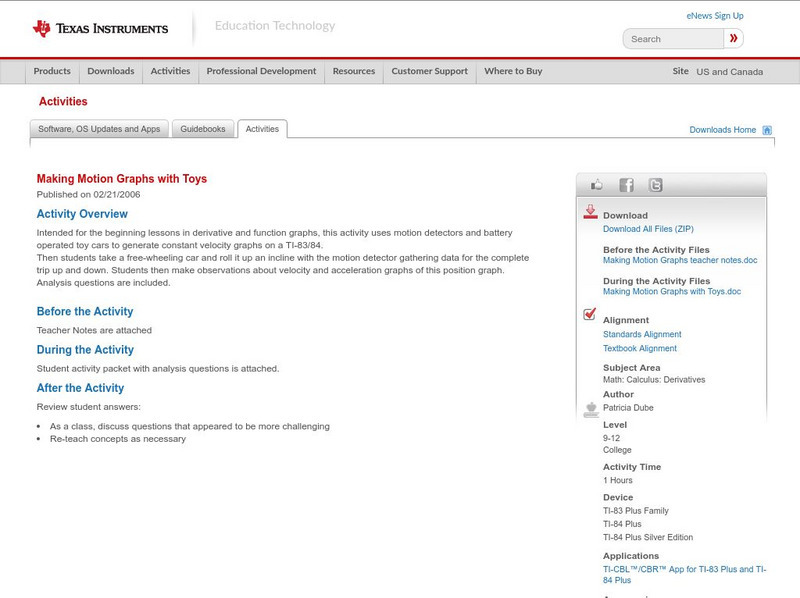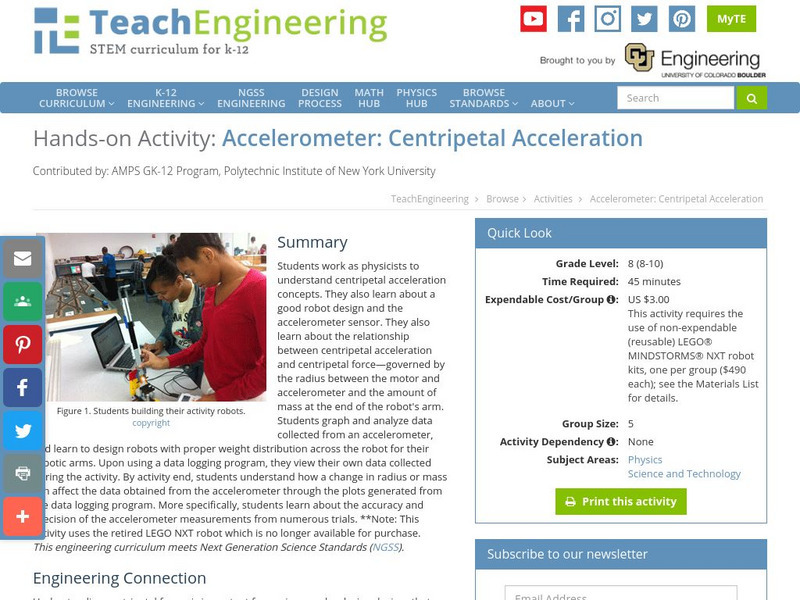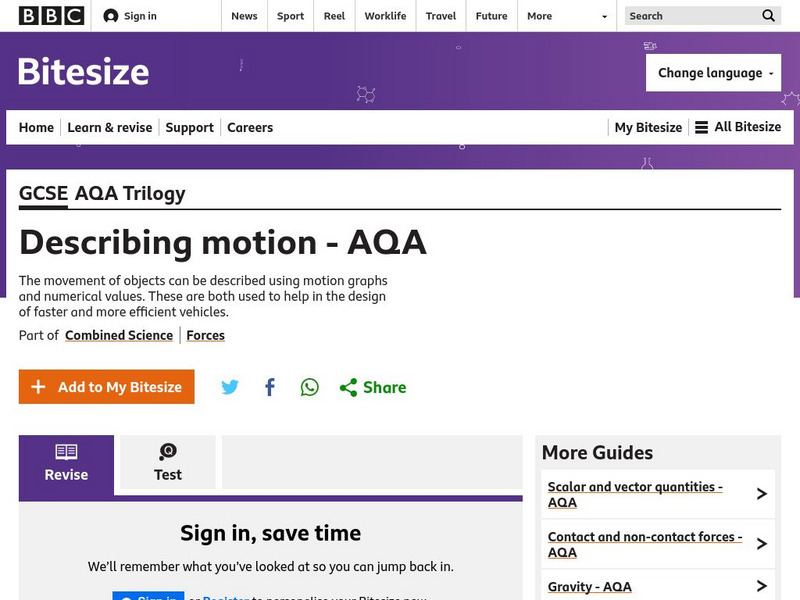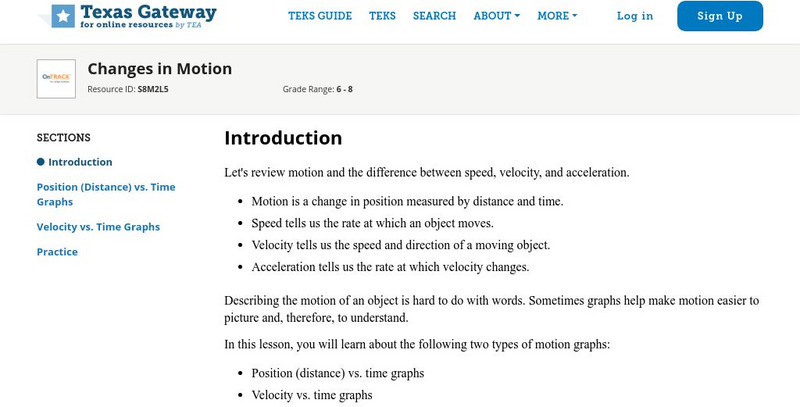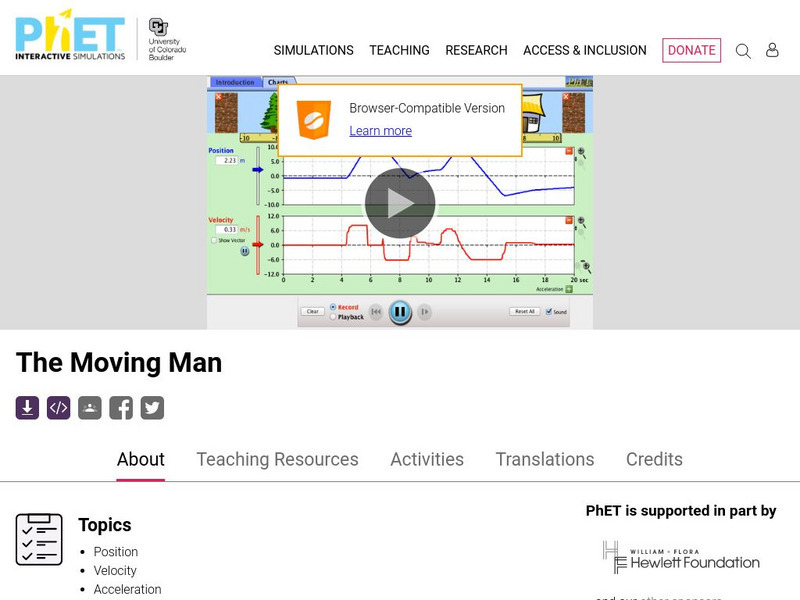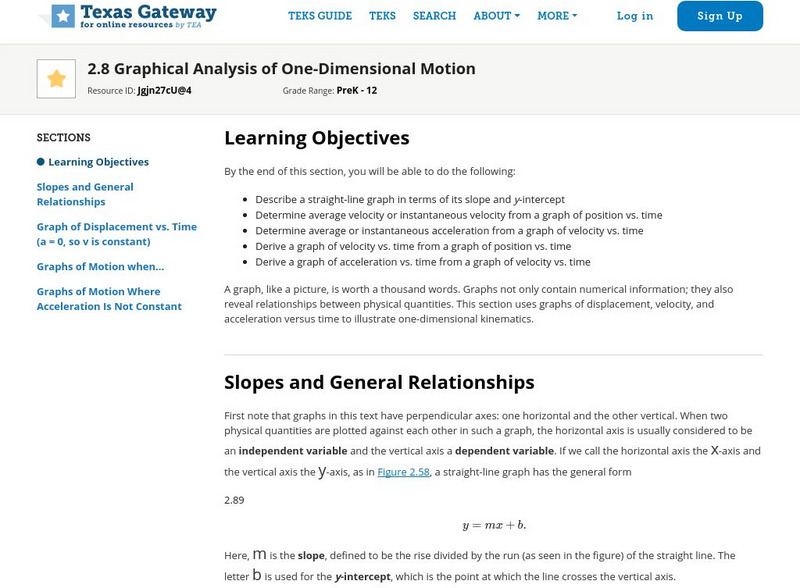Khan Academy
Khan Academy: Calculating Average Acceleration From Graphs
Practice calculating acceleration from velocity vs. time graphs
Texas Instruments
Texas Instruments: Making Motion Graphs With Toys
Intended for the beginning lessons in derivative and function graphs, this activity uses motion detectors and battery operated toy cars to generate constant velocity graphs on a TI-83/84. Then students take a free-wheeling car and roll...
Other
Institute of Physics: Practical Physics: Speed Time Graphs to Find an Equation
An illustrated example of a speed-time graph plotted with speed on the vertical axis against time on the horizontal axis.
Physics Aviary
Physics Aviary: Graphing Motion Problem Level 5
Find out the acceleration of an object from a position vs. time graph by finding the instantaneous velocity at two different points.
Physics Classroom
The Physics Classroom: 1 D Kinematics: Rightward Velocity and Acceleration
Through an animated illustration of a dot diagram and time graphs, students learn about positive velocity and positive acceleration.
Physics Aviary
Physics Aviary: Motion Graph Matching
You will be given a velocity vs. time graph for the motion of a car. Your job is to match the graph with your car by pushing on the gas or brake or coasting at the appropriate moments. Before you start the matching game, you must set the...
CK-12 Foundation
Ck 12: Plix Series: Uniform Acceleration
[Free Registration/Login Required] Using the average acceleration formula, calculate the velocity of a falling ball, and then check your answer by dragging the point along the line in the given graph. After the activity, answer one...
Science Education Resource Center at Carleton College
Serc: Newton's Second Law: How Does Acceleration Change With Varying Forces?
In this lab activity, students investigate the effects of changing force on the acceleration of a lab cart testing Newton's Second Law of Motion. They will use distance and time to calculate velocity and create a graph representing their...
Other
Socratic: What Is an Acceleration vs Time Graph?
Explains how to construct and interpret an acceleration vs. time graph, and how it would relate to a velocity vs. time graph or a position vs. time graph.
TeachEngineering
Teach Engineering: Accelerometer: Centripetal Acceleration
Students work as physicists to understand centripetal acceleration concepts. They also learn about a good robot design and the accelerometer sensor. They also learn about the relationship between centripetal acceleration and centripetal...
Physics Classroom
The Physics Classroom: 1 D Kinematics: Table of Contents
Learners examine motion with words, equations, diagrams, and graphs. Some topics investigated are position, velocity, acceleration, and free fall. The tutorial consists of lessons and problems to check for understanding.
Texas Instruments
Texas Instruments: Classroom Activities: Parachuting
This activity explores a parachutist and her position, velocity and acceleration. Graphing and calculating these functions will be required.
BBC
Bbc: Gcse Bitesize: Describing Motion Aqa
This lesson focuses on Distance-time graphs; the gradient of a distance-time graph represents the speed of an object.
Math Graphs
Houghton Mifflin: Math Graphs: Position, Velocity, and Acceleration [Pdf]
Students investigate the position, velocity, and acceleration graphs. The graphs are available in PDF format.
Texas Education Agency
Texas Gateway: Changes in Motion
In this lesson, you will learn about position vs. time graphs and velocity vs. time graphs and how to use them to solve problems.
Physics Aviary
Physics Aviary: Acceleration on a Planet Lab
This lab was designed to have students test the factors that affect the acceleration due to gravity on a planet. Students will be able to modify the planet and then drop an object to determine the acceleration on the planet. As the...
University of Colorado
University of Colorado: Ph Et Interactive Simulations: The Moving Man
Learn about position, velocity, and acceleration graphs. Move the little man back and forth with the mouse and plot his motion, and then set the position, velocity, or acceleration and let the simulation move the man for you.
Math Graphs
Houghton Mifflin: Math Graphs: Position, Velocity, and Acceleration [Pdf]
Students examine the graphs of the position, velocity, and acceleration functions of a particle. The example is available in PDF format.
Texas Education Agency
Texas Gateway: Kinematics: Graphical Analysis of One Dimensional Motion
By the end of this section, you will be able to describe a straight-line graph in terms of its slope and y-intercept, determine average velocity or instantaneous velocity from a graph of position vs. time, determine average or...
CK-12 Foundation
Ck 12: Physics: Motion Study Guide
This study guide on motion covers some key vocabulary and terms to describe motion: displacement vs. distance, acceleration, speed vs. velocity, and instantaneous vs. average. It includes graphs showing distance vs. time, velocity vs....
CK-12 Foundation
Ck 12 Exploration Series: Simulations: Physics: Butterfly Stroke
[Free Registration/Login Required] Learn about the relationship between velocity and position for a swimmer. Adjust the velocity of the legs, streamline, and arms to experiment with the slope of velocity in the simulation swimmer. Dig a...
CK-12 Foundation
Ck 12 Exploration Series: Simulations: Physics: Model Rocket
[Free Registration/Login Required] Learn about the relationship between position and velocity for a model rocket during launch and in free-fall. Experiment with rocket mass, rocket thrust, and rocket burn time to understand the...
CK-12 Foundation
Ck 12 Exploration Series: Simulations: Physics: Irwin and Ruthie
[Free Registration/Login Required] Learn about the relationship between position, velocity, and acceleration for two objects in one-dimensional motion. Experiment with varying approaches to the race for both Irwin and Ruthie to see how...
Texas Education Agency
Texas Gateway: Changes in Motion
Given diagrams or scenarios, students will measure and graph changes in motion.



